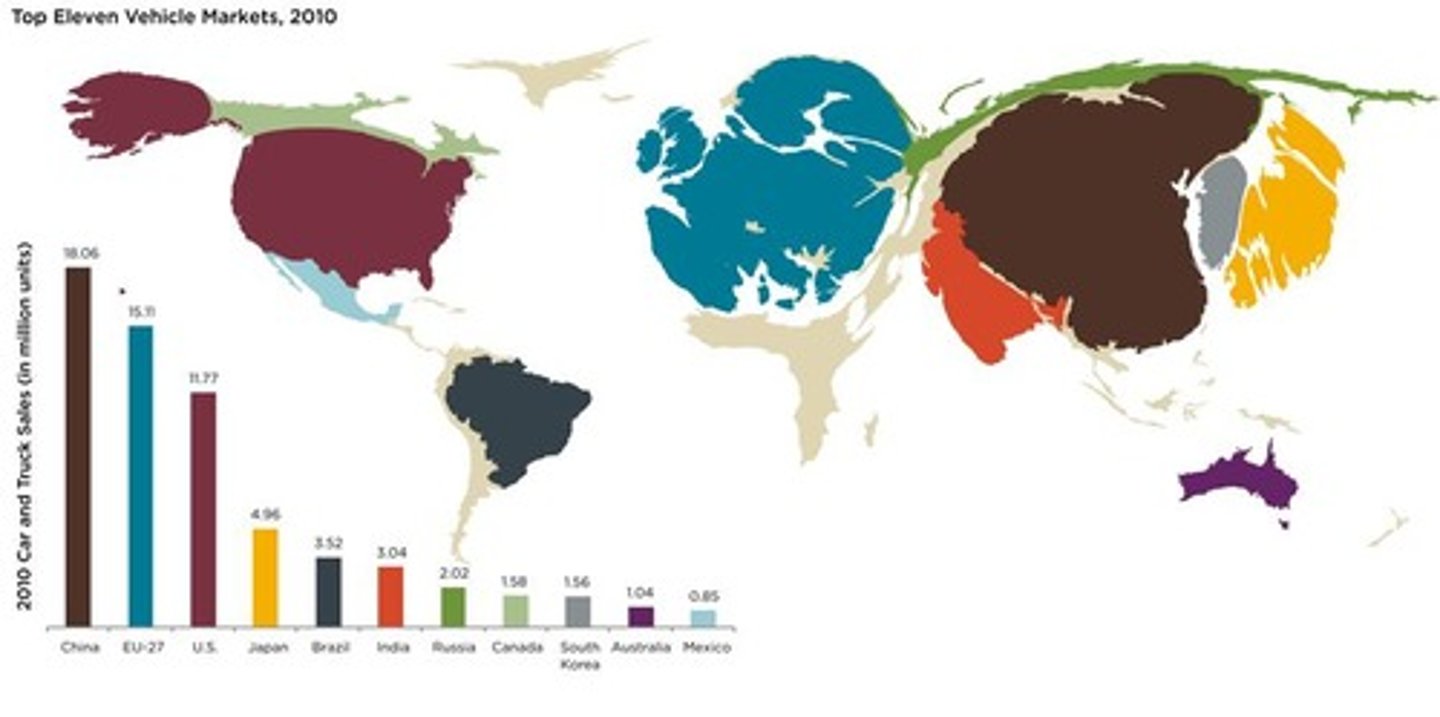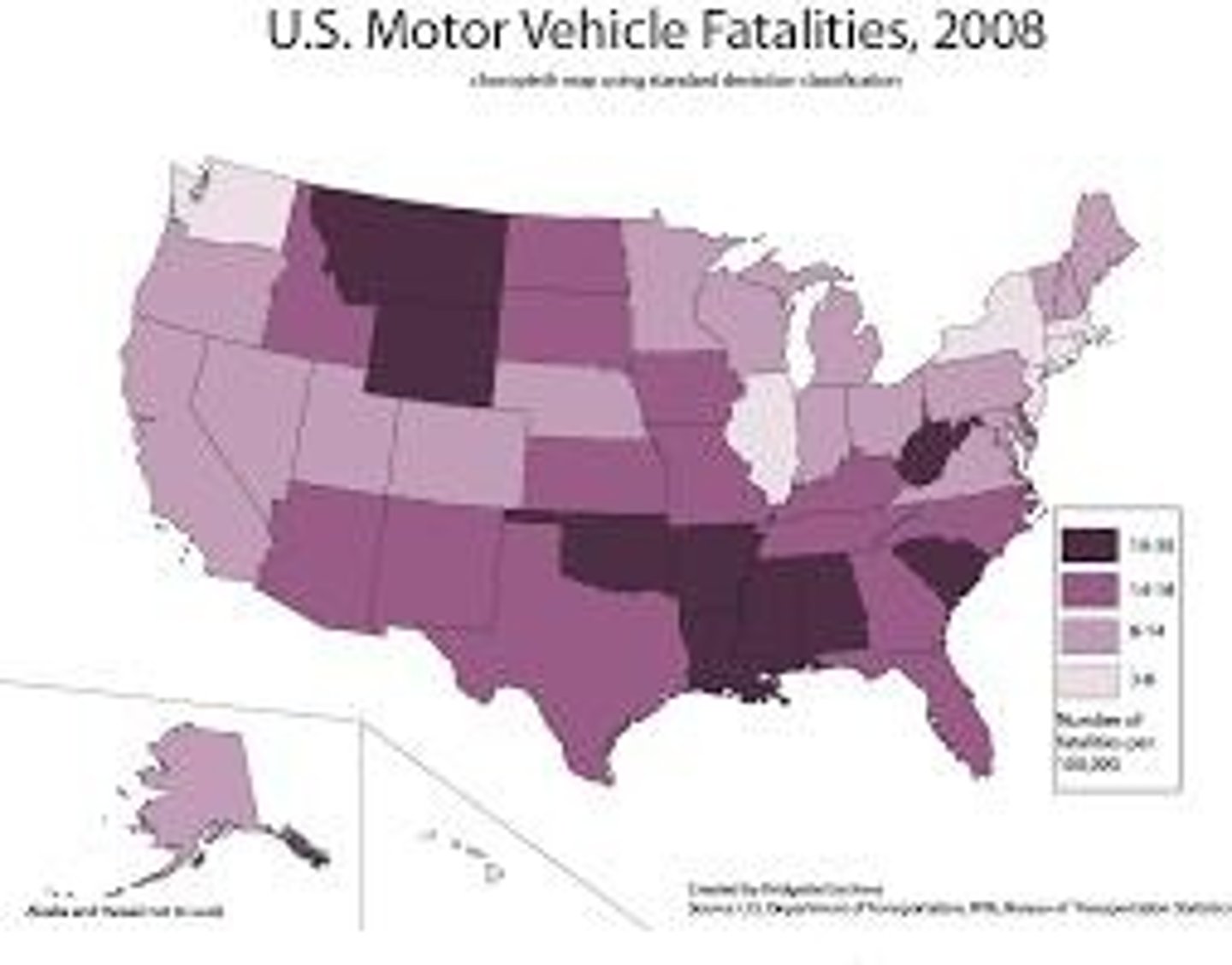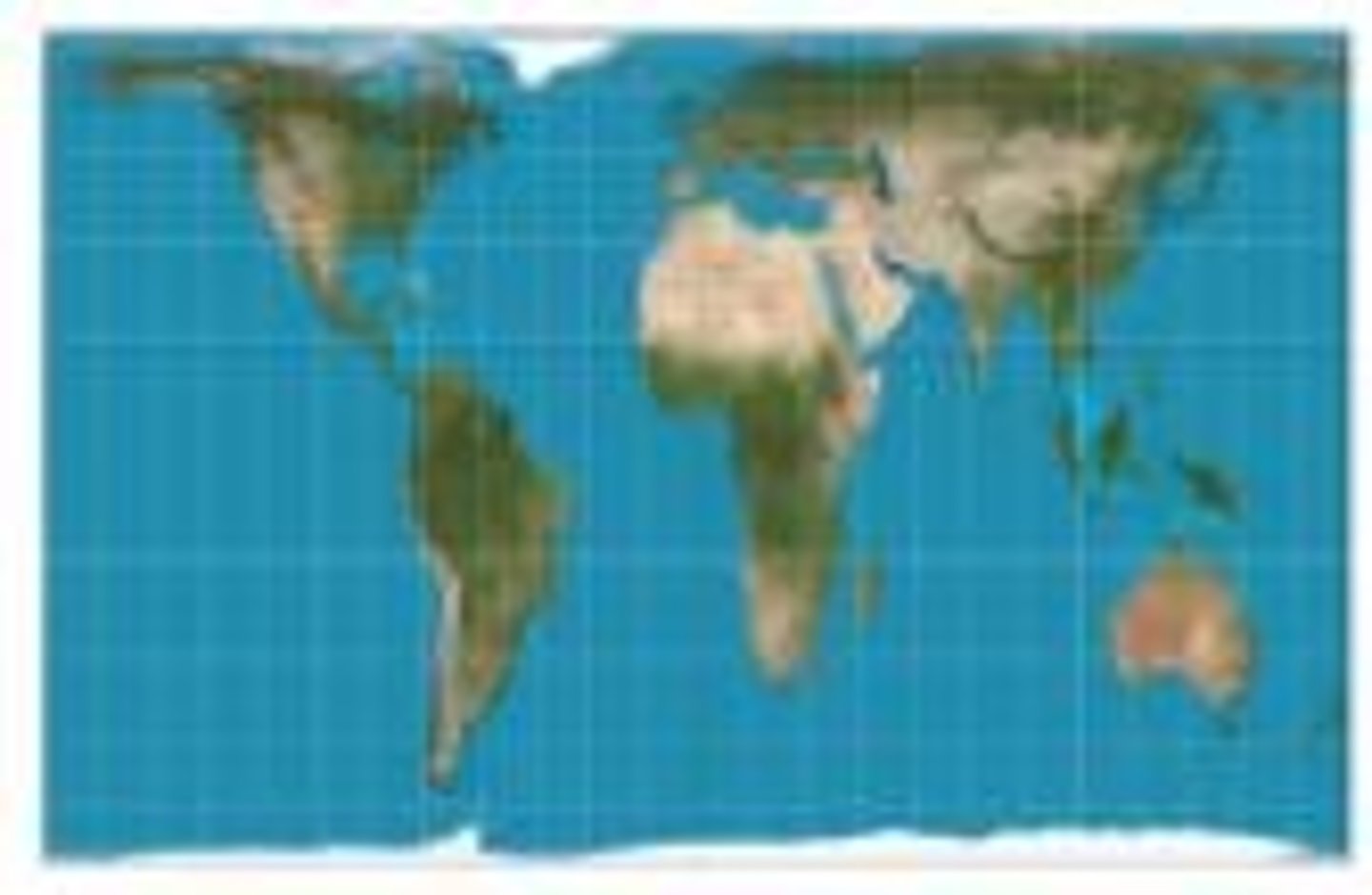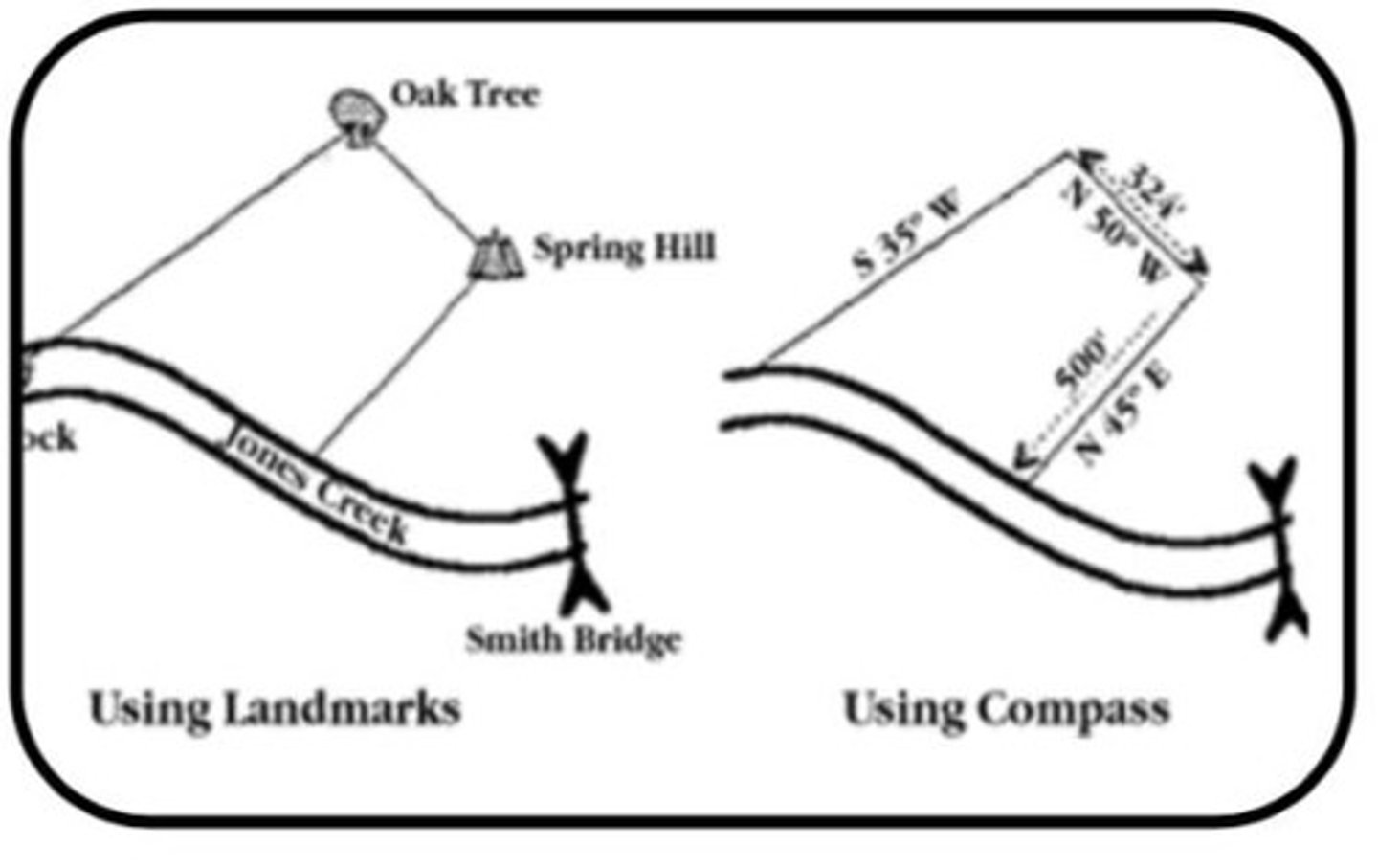Geography: Key Concepts and Theories in Human-Environment Interaction
1/442
There's no tags or description
Looks like no tags are added yet.
Name | Mastery | Learn | Test | Matching | Spaced |
|---|
No study sessions yet.
443 Terms
Reference maps
Designed for people to refer to for general information about places.
Thematic Maps
Used as a communications tool - tell us how human activities are distributed.
Isoline
A type of thematic map that uses lines to connect points of equal value.
Proportional Symbol
A thematic map that uses symbols of varying size to represent data.
Cartogram
A thematic map that distorts the size of geographic areas to represent data.

Choropleth
A thematic map that uses different shades or colors to represent data.

Dot Density
A thematic map that uses dots to represent the presence of a feature.
Clustering
Grouped/bunched together.
Dispersal
Appears to be distributed over a wide area.
Elevation
Using levels of how high/low something is located on the land.
Absolute distance
The exact measurement of space between two points.
Relative distance
The distance between two points as measured in terms of time or cost.
Robinson Map
Everything is distorted in small amounts.
Gall Peters
Shape of countries especially near the equator are distorted.
Mercator Map
Shape and directions of countries are fairly accurate but greatly distorted toward poles.

Goode
Continent sizes are accurately portrayed, but directions and distances aren't accurate.
Geospatial Data
All information including physical features and human activities.
Geographic Information System (GIS)
A computer system for capturing, storing, checking, and displaying data related to positions on Earth's surface.
GPS
Geographic Positioning System: This system uses data from satellites to pin-point a location on earth.

Remote sensing
The process of taking pictures of the Earth's surface from satellites or airplanes.
Census data
An official count of individuals in a population, occurring every 10 years in the USA.
Absolute location
The precise spot where something is located.
Relative Location
Where something is in relation to other things.
Distance Decay
A geographical term which describes the effect of distance on cultural or spatial interactions.
Time-Space Compression
The increasing sense of connectivity that seems to be bringing people closer together even though their distances are the same.
Sustainability
The goal of the human race reaching equilibrium with the environment; meeting the needs of the present while leaving resources for future generations.
Natural Resources
A physical material constituting part of Earth that people need and value.
Environmental Determinism
How the physical environment caused (determined) social development.
Possibilism
The physical environment may limit some human actions, but people have the ability to adjust to their environment.
Scale
The relationship between the distance on the ground and the corresponding distance on a specific map.
Scale of Analysis
How zoomed in or out you are when looking at geographic data.
Region
a place larger than a point and smaller than a planet that is grouped together because of a measurable or perceived common feature
Formal Region
a region that is based on quantitative data (that can be documented or measured) - all government areas are this because they share a government (Example: Wisconsin)
Functional Region
a region based around a node or focal point - terrestrial radio broadcasts are an example of this (example: Radio station broadcast area, DC metro)
Vernacular (Perceptual) Region
an area that shares a common qualitative characteristic, it's only a region because people believe it's a region (example: midwest)
Ecumene
a term used by geographers to mean where people are settled on the earth (along rivers, fertile land, coast, etc)
Physical Factors
People avoid areas too dry, too wet, too cold, too high
Cultural Factors
Populations will be concentrated in areas that have access to Education, health care, and entertainment opportunities
Historical Factors
certain areas where life could be sustained and lived (Areas where humans flourished and survived)
Arithmetic Density
total number of objects in an area
Physiological Density
Number of people supported by a unit area of arable land (Land suited for agriculture)
Agricultural Density
Ratio of the number of farmers to amount of arable land
Consequences of Population Distribution
Explain how population distribution and density affect society and the environment.
Carrying Capacity
the maximum population size of the species that the environment can sustain
Overpopulation
when there are not enough resources in an area to support a population
Age/sex ratio
comparison of the numbers of males and females of different ages
Population structure
is unique to each area due to their own unique history and current condition
Population Pyramid
a graph of the population of an area by age and sex - when a population is growing it takes a pyramid shape
Population Distribution
Identify the factors that influence the distribution of human populations at different scales.
Population Dynamics
Explain factors that account for contemporary and historical trends in population growth and decline.
Political Impact of Population Density
greater control over laws and larger influence
Economic Impact of Population Density
concentration of jobs, areas make more revenue
Social Impact of Population Density
greater access to health care, better educational opportunities, greater cultural diversity
Demography
the study of population
Crude Birth Rate (CBR)
the number of live births per one thousand people in the population
Crude Death Rate (CDR)
the number of deaths per one thousand people in the population
Doubling time
the time period it takes for a population to double in size
Fertility
the number of live births occurring in a population
Infant mortality rate (IMR)
the number of children who don't survive their first year of life per 1000 live births in a country
Mortality
the number of deaths occurring in a population
Infant Mortality Rate
number of babies that die during the first year per 1,000 live births
Rate of Natural Increase (RNI)
(birth rate - death rate)/10 - a positive NIR means a population is growing and a negative NIR means a population is shrinking
Total fertility rate (TFR)
the average number of children a woman is predicted to have in her child bearing (fecund) years
Demographic Transition Model
a model that explains theories of population growth and decline
Epidemiological Model
explains how society has developed and the change in how/why people are dying as we have progressed
Stage 1: Pestilence and Famine
characterized by high CDR where infectious diseases are principal causes of human deaths
Stage 2: Receding Pandemics
an epidemic that occurs over a wide geographic area and affects a very high proportion of the population, improved sanitation, medicine and better nutrition
Stage 3: Degenerative and Human-created diseases
characterized by a decrease in infectious diseases but an increase in chronic disorders associated with aging
Stage 4: Delayed Degenerative
major degenerative causes of death include cardiovascular diseases and cancers, but with extended life expectancy
Malthusian Theory
while population increases geometrically, food supply increases arithmetically, leading to potential shortages
Neo-Malthusian theory
earth's resources can only support a finite population, leading to pressure on scarce resources and advocating for family planning
Antinatalist policies
when a country provides incentives for people to have fewer children
Pronatalist policies
when a country provides incentives for people to have more children
Immigration policies
States can set up policies that make it easier or harder for people to immigrate to their territory
Women and Demographic Change
the changing role of females has demographic consequences in different parts of the world
Contraception
Methods of preventing pregnancy
Ravenstein's Laws of Migration
A set of principles outlining patterns and trends in human migration.
Step Migration
Migration proceeds step by step.
Economic Centers
Migrants going long distances generally go to large economic centers.
Compensating Counter-Stream
Each migration stream produces a compensating counter-stream.
Urban vs. Rural Migration
Natives of towns are less migratory than those of rural areas.
Gender Migration Patterns
Females are more migratory within their area of birth, but males migrate more frequently internationally.
Young Adult Migration
Most migrants are young adults; families rarely migrate out of their country.
Urban Growth
Large towns grow more as a result of migration than natural increases (Births).
Infrastructure and Migration
As infrastructure improves, migration increases with it.
Rural to Urban Migration
The major directions of migration is from the rural (agricultural) to urban (centers of industry and commerce).
Economic Causes of Migration
The major causes of migration are economic, such as seeking jobs and opportunity.
Dependency Ratio
The ratio of the number of people not in the workforce (dependents) to those who are in the workforce (producers).
Life Expectancy
The average number of years a person born in a country might expect to live.
Push Factors
Forces that drive people away from a place (e.g., no jobs, slavery, political instability).
Pull Factors
Forces that draw people to immigrate to a place (e.g., jobs, to be near family).
Intervening Opportunity
The presence of a nearer opportunity that diminishes the attractiveness of sites farther away.
Intervening Obstacle
A force or factor that may limit human migration (e.g., borders, laws, language).
Asylum Seeker
A person seeking residence in a country outside of their own because they are fleeing persecution.
Chain Migration
A series of migrations within a group that begins with one person who pulls others to migrate to the same area.
Step-Migration
Migration to a far away place that takes place in stages.
Forced Migration
When people migrate not because they want to but because they have no other choice.
Guest Worker
A legal immigrant who is allowed into the country to work, usually for a relatively short time period.
Internally Displaced Persons
A person forced to flee their home who remains in their home country.
Refugee
A person who flees their home country and is not able to return.